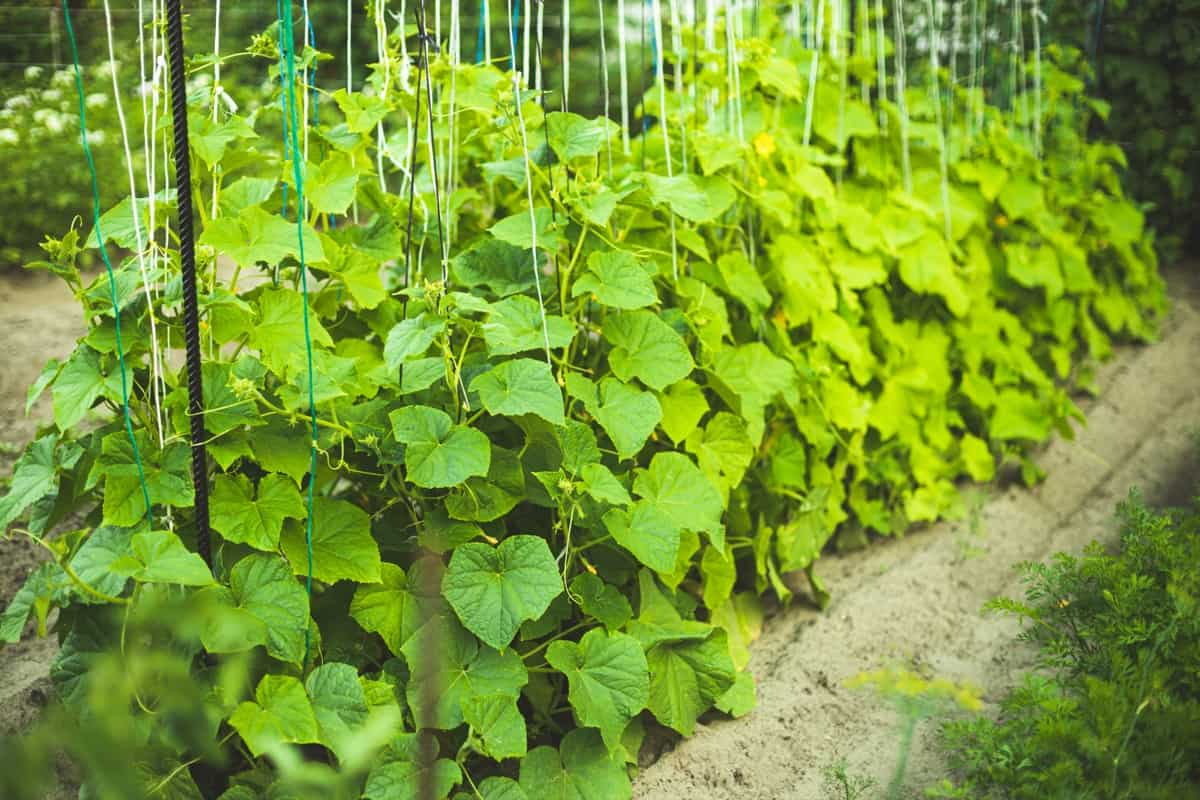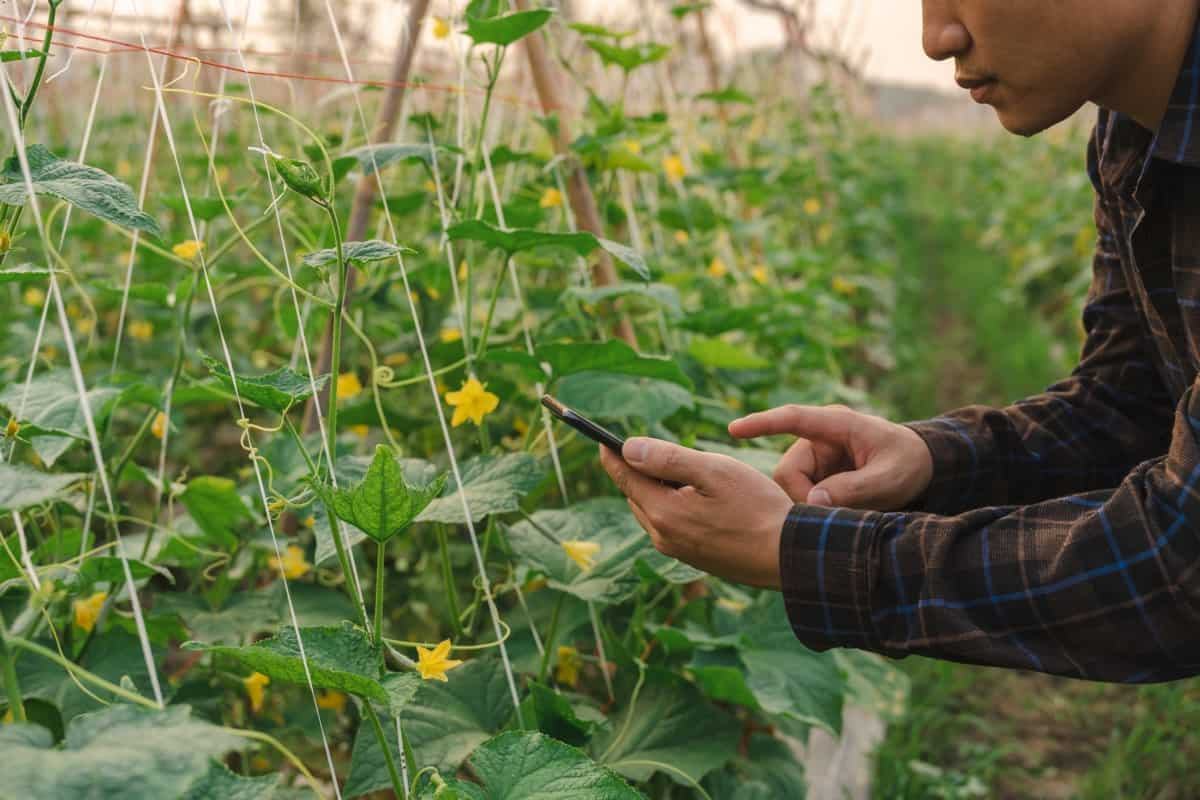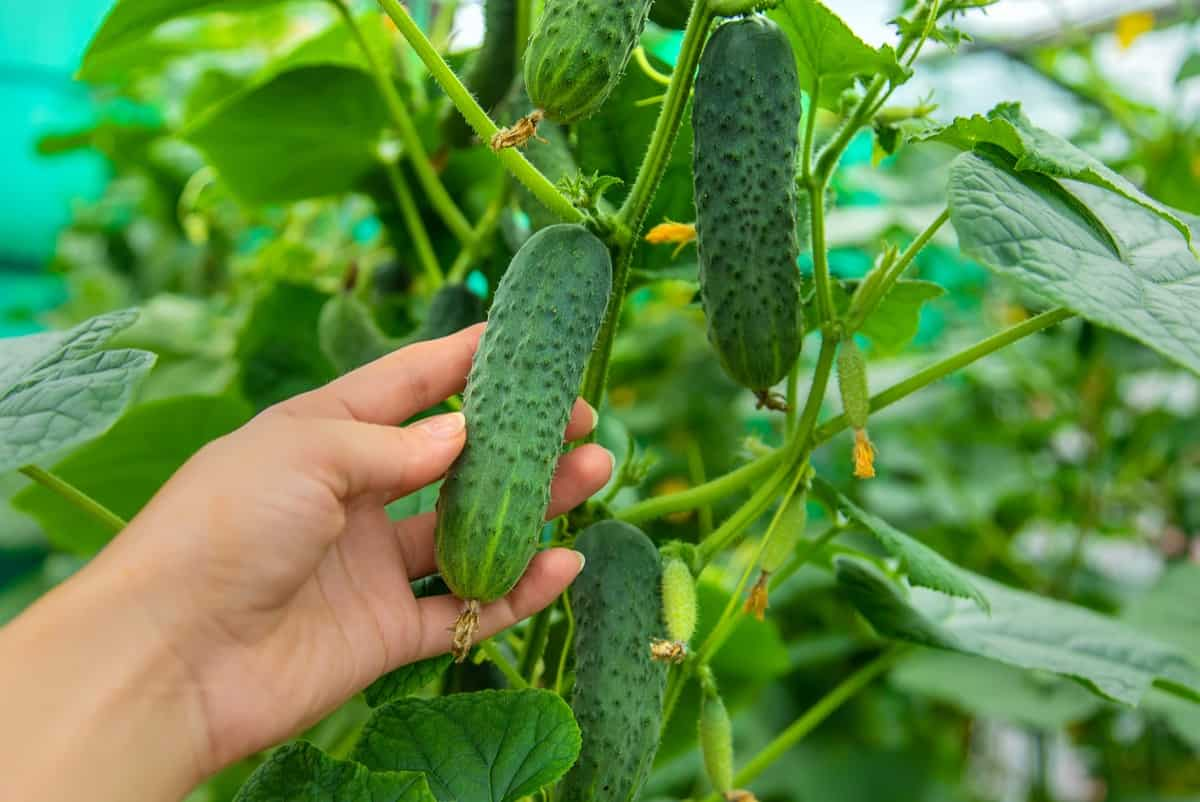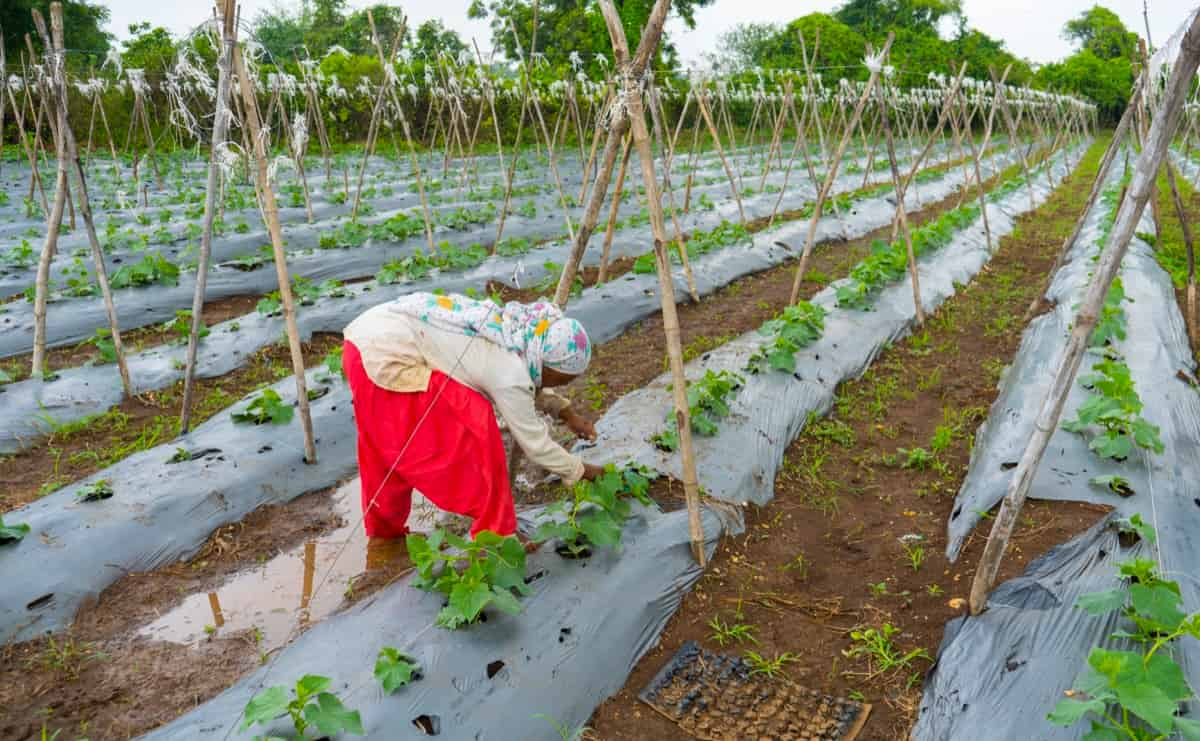Welcome to our comprehensive guide on Weed Management in Cucumber Farming! As every farmer knows, weeds can be a significant nuisance, competing with cucumber plants for essential resources and hampering their growth. This blog explores effective and sustainable strategies to tackle these pesky invaders.

We’ll delve into the importance of early weed identification and the proper use of pre-emergent herbicides. Discover how to implement mulching and cultivation techniques to suppress weeds while preserving soil health. Additionally, we’ll discuss the advantages of crop rotation and integrated pest management (IPM) approaches.
What is Weed Management in Cucumber Farming?
Weed management in cucumber farming is crucial for maximizing crop yield. Weeds compete with cucumbers for essential resources, yielding losses ranging from 45% to 95%, depending on climate conditions. Effective weed control requires a combination of preventive and control measures. Hand weeding is labor-intensive and may lead to weed re-establishment. When done at the right depth, cultivation techniques can help manage weeds without harming the crop.
Organic mulch, like green straw, aids in weed control, water conservation, and soil surface cooling. Care must be taken to avoid mulching materials with high carbon-to-nitrogen ratios competing with crops for nitrogen. Though herbicides are limited in cucumber weed control, integrated approaches combining tillage, competitive varieties, herbicides, and technology like remote sensing and robotics offer effective and environmentally friendly solutions.
Organic Weed Control Methods for Cucumber Farming
Organic weed control methods are essential for maintaining a healthy cucumber crop without resorting to chemical pesticides. Preventive weed management involves clean cultivation, weed-free seeds and fertilizers, and farm environments. Crop rotation, a cultural weed management practice, helps improve weed control and soil productivity.
It involves shifting cucumber cultivation to different crops with diverse life cycles and physiologies. Using implements like moldboard plows, primary tillage can reduce weed density during early cucumber growth stages. The stale seedbed technique prepares the field, controlling resurgent weeds through tillage and germinating and killing young weed seedlings.
Soil solarization, done during hot summers with transparent polyethylene sheets, raises soil temperatures to kill weed seeds and seedlings. Manipulating cucumber plant density and row spacing through narrow spacing and high plant densities helps enhance the cucumber’s competitive ability against weeds, promoting a weed-free crop. These environmentally friendly and cost-effective approaches provide effective weed management for organic cucumber farming.
In case you missed it: Key Rules to Increase Female and Male Flowers in Cucumbers

Integrated Weed Management Practices in Cucumber Cultivation
Integrated weed management is essential for sustainable cucumber farming, as no single method can efficiently tackle diverse weed problems. Cucumber growers should adopt an integrated approach to achieve effective and eco-friendly weed control. This approach uses physical, mechanical, chemical, and biological tactics for direct weed control.
Additionally, cultural and agronomic practices, such as planting patterns, fertilization timing and placement, row spacing, and intercropping, can indirectly influence weed density and development. Combining various methods maximizes weed control and efficiency in an economical and environmentally responsible manner. By utilizing all available options in coordination, farmers can achieve better weed management results, ensuring a healthy and productive cucumber crop.
Chemical-free Weed Management Techniques for Cucumbers
Chemical-free weed management techniques for cucumbers are gaining popularity among farmers and consumers. These methods offer environmentally friendly alternatives to traditional chemical herbicides. One effective technique is mulching. Organic mulches like straw or hay can be applied around cucumber plants, suppressing weed growth while retaining soil moisture and temperature.
Hand weeding is another chemical-free option, although it may require more labor. Timely and consistent removal of weeds prevents them from competing with cucumber plants for resources. Cultivation practices, such as shallow hoeing or tilling, can disrupt weed growth without chemicals. Cover cropping is also beneficial; planting fast-growing cover crops can outcompete weeds and add organic matter to the soil when turned under. Additionally, crop rotation helps to reduce weed pressure in cucumber fields.
Sustainable Weed Control Strategies in Cucumber Farms
- Mulching: Applying organic mulch, such as straw or compost, suppresses weed growth by blocking sunlight and inhibiting weed seed germination. It also conserves soil moisture and improves soil health.
- Crop Rotation: Rotating cucumber with different crops disrupts weed life cycles and reduces weed pressure. Crops with different growth habits and timing create less favorable conditions for weeds to establish.
- Cover Crops: Planting cover crops in fallow periods competes with weeds for resources, reduces weed seed germination, and improves soil structure.
- Hand Weeding: Manual removal of weeds is labor-intensive but environmentally friendly, especially for organic farming.
- Cultivation: Mechanical cultivation, like hoeing or tilling, disrupts weed growth and helps control weed during the early stages of cucumber growth.
- Biological Control: Introducing beneficial insects or using natural enemies of weeds can help control specific weed species.
- Herbicides: Selective and approved herbicides, when used judiciously, can effectively control weeds without harming crops or the environment.
- Integrated Weed Management: Combining several control strategies in a coordinated manner optimizes weed control, promoting sustainability and higher cucumber yields.
In case you missed it: How this Farmer Earning 40 Lakhs from His Cucumber Farm: a Success Story of a Polyhouse Farmer in India

Weed Suppression Methods for Successful Cucumber Production
Weeds significantly threaten successful cucumber production, leading to 45-95% yield losses, depending on climatic conditions. Weed management is crucial, especially during the early growth stages of cucumber plants. Hand weeding and cultivation techniques can be effective but labor-intensive and time-consuming.
Organic mulching with green straw can control weeds and reduce water loss through evaporation, but materials with high carbon-to-nitrogen ratios should be avoided to prevent competition for nitrogen. Herbicides are limited in cucumber weed control and may not cover the entire weed spectrum. Integrated weed management is recommended, involving prevention and control measures.
Mulching as a Weed Management Approach in Cucumber Farming
Mulching is an effective weed management approach in cucumber farming that involves covering the soil surface around cucumber plants with organic or synthetic materials. The mulch is a protective layer, suppressing weed growth by blocking sunlight and preventing weed seed germination. Organic mulches like straw or compost control weeds and improve soil health and water retention. They create a favorable environment for cucumber plants to grow and thrive while reducing the competition from weeds.
Like black plastic, synthetic mulches are also used in cucumber farming for weed suppression. They create a physical barrier that inhibits weed growth while warming the soil and promoting early plant growth. Mulching is a sustainable and environmentally friendly method that minimizes the need for chemical herbicides. It helps to conserve soil moisture, reduce weed pressure, and ultimately enhance cucumber yield and quality.
Pre-emergence Herbicides for Controlling Weeds in Cucumbers
These herbicides are applied to the soil before weed seeds germinate, preventing weed emergence and growth. By targeting weeds early in their life cycle, pre-emergence herbicides effectively suppress weed populations and reduce competition with cucumber plants for essential resources.
One example of a pre-emergence herbicide commonly used in cucumber farming is Pendimethalin. It provides excellent control against a broad spectrum of weeds, including annual grasses and many broadleaf weeds. Pendimethalin forms a barrier in the soil, inhibiting weed seedlings from establishing roots and shoots.
Another popular pre-emergence herbicide is Metolachlor. It targets various grass and broadleaf weed species, providing long-lasting control during the critical early stages of cucumber growth. S-metolachlor is also used as a pre-emergence herbicide, offering effective control against grass and certain broadleaf weeds.
Post-emergence Weed Control Options for Cucumber Growers
Post-emergence weed control options are crucial for cucumber growers to manage weeds that have already emerged. These methods target weeds after sprouting and can help prevent competition with cucumber plants. Some effective post-emergence herbicides for cucumber farming include glyphosate, clethodim, sethoxydim, and bentazon. Glyphosate is a broad-spectrum herbicide that controls many weed species.
Clethodim and sethoxydim are selective herbicides that target grassy weeds, making them ideal for controlling specific weed types while sparing cucumber plants. Bentazon is effective against broadleaf weeds like pigweed and morning glories. Proper application and timing are essential to maximize the effectiveness of these herbicides and minimize the risk of crop damage. Additionally, integrated weed management approaches combine post-emergence herbicides with other methods like cultivation and mulching.
In case you missed it: Vertical Cucumber Farming for the Urban Gardener: Clever Ways to Get More Yields from Small Spaces

Selective Herbicides for Managing Weeds in Cucumber Fields
Selective herbicides are essential tools for managing weeds in cucumber fields. Unlike non-selective herbicides that kill all vegetation they meet, selective herbicides target specific weed species while sparing the cucumber plants. These herbicides inhibit certain biochemical processes unique to weeds, allowing cucumber crops to thrive without competition. One example of a selective herbicide commonly used in cucumber farming is Metolachlor.
It effectively controls grass and broadleaf weeds, including common lambsquarters and pigweeds, while being safe for cucumber plants. Another selective herbicide is sethoxydim, which targets grassy weeds like crabgrass and foxtail without harming cucumbers. Following label instructions and using these herbicides at the recommended rates and timing is crucial to ensure effective weed control and protect the cucumber crop.
Non-chemical Weed Management Alternatives for Cucumbers
Non-chemical weed management alternatives for cucumbers include mechanical methods. Mechanical weed management involves physically removing weeds from the field using tools like hand hoes, cutlasses, cultivators, mowers, and weeders. Primary and secondary tillage practices are part of mechanical weed management. Plowing or disking exposes weeds to light, moisture, and temperature variations, effectively destroying them.
However, mechanical methods may not provide season-long control as some weed seeds can remain near the soil surface. To ensure better weed control, it’s essential to use mechanical weed management before or during early flowering to prevent weed seed production. It is important to note that relying solely on mechanical weed control may lead to the emergence and dispersal of dormant weed seeds and negatively impact soil structure, causing dryness and compaction.
Cultural Practices to Minimize Weed Growth in Cucumber Farms
Cultural practices play a crucial role in minimizing weed growth in cucumber farms. Weed interference in cucumber can cause significant yield losses, ranging from 45% to 95%, depending on weed type, density, duration of interference, and crop variety. Weeds compete with cucumber for essential resources such as nutrients, water, light, and space, negatively affecting crop productivity and profitability. Weed interference can also indirectly impact cucumber production by harboring crop pests and diseases and hindering harvest efficiency.
Cultural practices like timely weed removal, crop rotation, and row spacing management are essential to minimize weed growth. The critical period of weed control (CPWC) is when weeds need to be controlled to prevent yield losses. The CPWC for cucumber varies across different locations, climates, and management practices, typically ranging from 4 to 6 weeks after sowing in the USA and 3 to 7 weeks after sowing in Brazil.
In case you missed it: How to Protect Cucumber and Squash Plants from Powdery Mildew: Causes, and Treatment

Biological Control Agents for Suppressing Weeds in Cucumber Cultivation
Biological control agents are beneficial organisms used to suppress weeds in cucumber cultivation. These natural enemies can include insects, mites, pathogens, and nematodes that target specific weed species. They help reduce weed growth by feeding on or infecting the weeds, limiting their spread and competitive ability with cucumbers.
For example, certain insects like weevils and moths are known to feed on specific weed plants, while fungal pathogens can infect and kill weed species. Implementing biological control agents in cucumber farms offers an environmentally friendly and sustainable approach to weed management, reducing the reliance on chemical herbicides and promoting a balanced ecosystem for successful cucumber production.
Herbicide-resistant Weed Species in Cucumber Production and Their Management
Some weeds have resisted commonly used herbicides, making them challenging to control. Over time, the widespread use of a single herbicide has contributed to the development of resistance. Some common herbicide-resistant weed species in cucumber farms include pigweed, lambsquarters, and ryegrass.
To manage these resistant weeds effectively, an integrated approach is essential. This approach includes using multiple herbicides with different modes of action, rotating herbicides, employing cultural practices like crop rotation and cover cropping, and using non-chemical weed control methods like mechanical and hand weeding.
Weed Monitoring and Scouting Techniques for Effective Cucumber Farm Management
Weed monitoring and scouting are techniques for effective cucumber farm management. Regularly observing and assessing weed populations and their growth stages allow farmers to make informed decisions for weed control strategies. Scouting techniques involve physically inspecting the fields and identifying weed species, their density, and distribution patterns. Monitoring methods can include remote sensing technologies, such as drones or satellite imagery, to assess weed infestations across larger areas.
In case you missed it: Top 20 Steps to Boost Cucumber Yield: How to Increase Cucumber Size, Quality, and Production

Conclusion
Effective weed management in cucumber farming prevents yield losses and ensures crop productivity. Integrated approaches, timely monitoring, and appropriate cultural practices are key to minimizing weed interference and maximizing cucumber yields.
- Modern Sheep Farming Technology: The Future of Sheep Husbandry
- Goat Farming Technology: The Future of Goat Husbandry
- How to Build a Low-budget Goat Shed: Cheap Ideas and Tips
- Goat Farming Training Programs in India: A Beginner’s Guide
- Types of Pesticides Used in Agriculture: A Beginner’s Guide
- Economical Aquaculture: A Guide to Low-Budget Fish Farming
- 15 Common Planting Errors That Can Doom Your Fruit Trees
- How to Make Houseplants Bushy: Effective Tips and Ideas
- Innovative Strategies for Boosting Coconut Pollination and Yield
- Pollination Strategies for Maximum Pumpkin Yield
- The Complete Guide to Chicken Fattening: Strategies for Maximum Growth
- Natural Solutions for Tulip Problems: 100% Effective Remedies for Leaf and Bulb-Related Issues
- Revolutionizing Citrus Preservation: Towards a Healthier, Greener Future
- Natural Solutions for Peony Leaf and Flower Problems: 100% Effective Remedies
- Maximizing Profits with Avocado Contract Farming in India: A Comprehensive Guide
- Natural Solutions for Hydrangea Problems: 100% Effective Remedies for Leaf and Flowers
- The Ultimate Guide to Choosing the Perfect Foliage Friend: Bringing Life Indoors
- From Sunlight to Sustainability: 15 Ways to Use Solar Technology in Agriculture
- The Ultimate Guide to Dong Tao Chicken: Exploring from History to Raising
- The Eco-Friendly Makeover: How to Convert Your Unused Swimming Pool into a Fish Pond
- Mastering the Art of Delaware Chicken Farming: Essentials for Healthy Backyard Flocks
- 20 Best Homemade Fertilizers for Money Plant: DIY Recipes and Application Methods
- How to Craft a Comprehensive Free-Range Chicken Farming Business Plan
- Brighten Your Flock: Raising Easter Egger Chickens for Beauty and Bounty
- How to Optimize Your Poultry Egg Farm Business Plan with These Strategies
- Subsidy for Spirulina Cultivation: How Indian Government Schemes Encouraging Spirulina Farmers
- Ultimate Guide to Raising Dominique Chickens: Breeding, Feeding, Egg-Production, and Care
- Mastering the Art of Raising Jersey Giant Chickens: Care, Feeding, and More
- Ultimate Guide to Raising Legbar Chickens: Breeding, Farming Practices, Diet, Egg-Production
- How to Raise Welsummer Chickens: A Comprehensive Guide for Beginners
- How to Protect Indoor Plants in Winter: A Comprehensive Guide
- Ultimate Guide to Grow Bag Gardening: Tips, Tricks, and Planting Ideas for Urban Gardeners
- Guide to Lotus Cultivation: How to Propagate, Plant, Grow, Care, Cost, and Profit
- Agriculture Drone Subsidy Scheme: Government Kisan Subsidy, License, and How to Apply Online
- Ultimate Guide to Raising Araucana Chickens: Breed Profile, Farming Economics, Diet, and Care
- Bringing Hydroponics to Classroom: Importance, Benefits of Learning for School Students